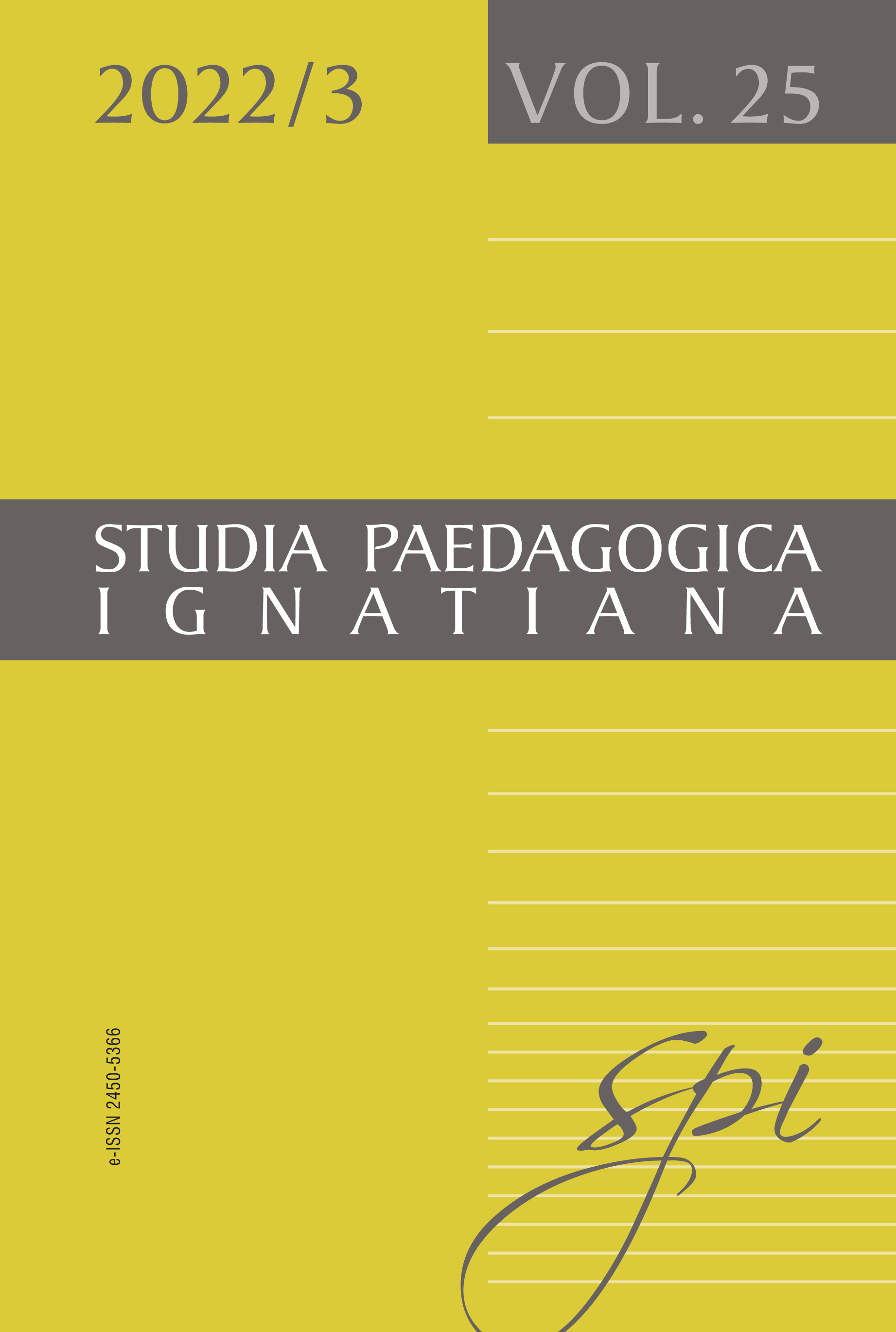Ethics in Educational Science Fiction in the Era of Transhumanism and Posthumanism
DOI:
https://doi.org/10.12775/SPI.2022.3.008Keywords
transhumanism, posthumanism, education, pedagogy, ethics, cyborg, human enhancementAbstract
Education is a continuous process of preparing young people to enter adulthood, of equipping them with the tools and knowledge necessary to cope in the future so that they can cope both in the labor market and in their personal life as well as in functioning in society. It is also, in its own way, a process of “human enhancement.” This article aims to introduce the fashionable and widely commented philosophical concepts of transhumanism and posthumanism. First, some of the most famous and popular visions of the future from visionaries at the end of the 19th century are presented, with a particular emphasis on those that have in some way come true. In the next part of the article, the very concepts of transhumanism and posthumanism are clarified, along with a presentation of the most important differences. In the last part, the educational challenges posed by proponents of these philosophical movements are indicated, as well as the main ethical problems that arise in the world of futuristic visionaries.
References
Bishop J.P. (2010). Transhumanism, Metaphysics, and the Posthuman God, „Journal of Medicine & Philosophy”, t. 35, nr 6, s. 700–720.
Bostrom N. (2003). Ethical Issues in Advanced Artificial Intelligence, [w:] I. Smit, W. Wallach, G.E. Lasker (red.), Cognitive, Emotive and Ethical Aspects of Decision Making in Humans and in Artificial Intelligence, t. 2, Tecumseh (ON): International Institute of Advanced Studies in Systems Research and Cybernetics, s. 12–17.
Bostrom N. (2005). Transhumanist Values, „Journal of Philosophical Research”, t. 30 (Supplement), s. 3–14.
Casten J.D. (2012). Cybernetic Revelation: Deconstructing Artificial Intelligence, Eugene (OR): Post Egoism Media, s. 697–698.
Duchliński P. (2018). Transhumanistyczny obraz świata. Próba spojrzenia na całość, [w:] G. Hołub, P. Duchliński (red.), Ulepszanie człowieka. Perspektywa filozoficzna, Kraków: Wydawnictwo Naukowe Akademii Ignatianum w Krakowie, s. 281–300.
Ferrando F. (2013). Posthumanism, Transhumanism, Antihumanism, Metahumanism, and New Materialisms: Differences and Relations, „An International Journal in Philosophy, Religion, Politics and the Arts”, t. 8, nr 2, s. 26–32.
Gladden M.E. (2016). A Typology of Posthumanism: A Framework for Differentiating Analytic, Synthetic, Theoretical, and Practical Posthumanisms, [w:] M.E. Gladden, Sapient Circuits and Digitalized Flesh: The Organization as Locus of Technological Posthumanization, Indianapolis (IN): Defragmenter Media, s. 31–91.
Huxley J. (1968). Transhumanism, „Journal of Humanistic Psychology”, t. 8, nr 1, s. 73–76.
Kriman A.I. (2019). The Idea of the Posthuman: A Comparative Analysis of Transhumanism and Posthumanism, „Russian Journal of Philosophical Sciences = Filosofskie nauki”, t. 62, nr 4, s. 132–147.
Kruger F. (2016). Posthumanism and Educational Research for Sustainable Futures, „Journal of Education”, nr 65, s. 77–93.
McNamee M.J., Edwards S.D. (2006). Transhumanism, Medical Technology and Slippery Slopes, „Journal of Medical Ethics”, t. 32, nr 9, s. 513–518.
Müller V.C. (2016). Editorial: Risks of Artificial Intelligence, [w:] V.C. Müller (red.), Risks of General Intelligence, London: CRC Press – Chapman & Hall, s. 1–8.
Osiński G. (2021). Theological and Ethical Aspects of Mind Transfer in Transhumanism, „Scientia et Fides”, t. 9, nr 1, s. 149–176.
Roden D. (2017). On Reason and Spectral Machines: Robert Brandom and Bounded Posthumanism, [w:] R. Braidotti, R. Dolphijn (red.), Philosophy After Nature, London: Rowman & Littlefield, s. 99–119.
Sotala K. (2012). Advantages of Artificial Intelligences, Uploads, and Digital Minds, „International Journal of Machine Consciousness”, t. 4, nr 1, s. 275–291.
Steinhoff J. (2014). Transhumanism and Marxism: Philosophical Connections, „Journal of Evolution and Technology”, t. 24, nr 2, s. 1–16.
Sykulski L. (2013). Rosyjski transhumanizm: geneza i współczesność, „Ante Portas. Studia nad Bezpieczeństwem”, nr 2, s. 89–101.
Netografia
Andrews R. (2017). Scientists Connect a Human Brain to the Internet for the First Time, https://www.iflscience.com/scientists-connect-human-brain-internet-first-time-43726 [dostęp: 18.03.2022].
Tesla N. (1915). Nikola Tesla Sees a Wireless Vision, https://teslaresearch.jimdofree.com/articles-interviews/nikola-tesla-sees-a-wireless-vision-new-york-times-sunday-october-3-1915/ [dostęp: 5.03.2022].
Yampolskiy R. (2020). On Controllability of Artificial Intelligence, https://arxiv.org/ftp/arxiv/papers/2008/2008.04071.pdf [dostęp: 26.03.2022].
Wits University (2017). Biomedical Engineers Connecting a Human Brain to the Internet in Real Time, „Medical Press” 14.09.2017, https://medicalxpress.com/news/2017-09-biomedical-human-brain-internet-real.html [dostęp: 18.03.2022].
Downloads
Published
How to Cite
Issue
Section
License
Copyright (c) 2022 Andrzej Skupień

This work is licensed under a Creative Commons Attribution-NoDerivatives 4.0 International License.
By submitting an article, the author declares that:
they are the author of the article (hereinafter referred to as the Work) and:
- is entitled to exclusive and unlimited copyright to the Work,
- is entitled to dispose of the copyrights to the Work.
The Author grants the Jesuit University Ignatianum in Cracow a free, non-exclusive, territorially unlimited license to use the Work in the following fields of exploitation:
- publishing the Work in paper, digital or magnetic form;
- multiplying the work by any method, without limiting the number of editions or copies;
- distribution of the work and its copies in any form, including marketing, sales, lending, and lease;
- placing the work in a computer memory;
- distribution of the work in information networks, including the Internet;
- public performance, exhibition, display, reproduction, broadcasting and re-broadcasting, as well as making the Work available to the public in such a manner that everyone could have access to it at a time and place chosen by themselves;
- within the scope of dependent rights to the Work, covering, in particular, the right to make necessary changes to the Work, resulting from editorial and methodical preparation, as well as to make translations of the Work into other languages.
The license right shall be transferred the moment of transfer of the Work to the Jesuit University Ignatianum in Cracow. The Jesuit University Ignatianum in Cracow is entitled to grant sub-licenses to the Work in terms of the right granted. The license shall be limited in time for a period of 15 years from the date it is granted.
Stats
Number of views and downloads: 1432
Number of citations: 0



